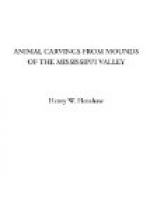The cougar, to which several of the carvings can with but little doubt be referred, was at the time of the discovery of America and is to-day, where not exterminated by man, a common resident of the whole of North America, including of course the whole of the Mississippi Valley. It would be surprising, therefore, if an animal so striking, and one that has figured so largely in Indian totemism and folk-lore, should not have received attention at the hands of the Mound-Builders.
Nothing resembling the toucan, as has been seen, has been found in the mounds; but, as stated, this bird is found in Southern Mexico.
The buzzard is to-day common over almost the entire United States, and is especially common throughout most of the Mississippi Valley.
As to the paroquet, there seems to be no evidence in the way of carvings to show that it was known to the Mound-Builders, although that such was the case is rendered highly probable from the fact that it lived at their very doors.
It therefore appears that of the five animals of which Wilson states “the majority are not known in the United States,” and “some of them are totally unknown, within any part of the North American continent,” every one is found in North America, and all but one within the limits of the United States, while three were common residents of the Mississippi Valley.
As a further illustration of the inaccurate zoological knowledge to which may be ascribed no small share of the theories advanced respecting the origin of the Mound-Builders, the following illustration may be taken from Wilson, this author, however, being but one of the many who are equally in fault. The error is in regard to the habitat of the conch shell, Pyrula (now Busycon) perversa.
After exposing the blunder of Mr. John Delafield, who describes this shell as unknown on the coasts of North and South America, but as abundant on the coast of Hindostan, from which supposed fact, coupled with its presence in the mounds, he assumes a migration on the part of the Mound-Builders from Southern Asia (Prehistoric Man, vol. 1, p. 219, ibid., p. 272), Wilson states.
No question can exist as to the tropical and marine origin of the large shells exhumed not only in the inland regions of Kentucky and Tennessee, but in the northern peninsula lying between the Ontario and Huron Lakes, or on the still remoter shores and islands of Georgian Bay, at a distance of upwards of three thousand miles from the coast of Yucatan, on the mainland, the nearest point where the Pyrula perversa is found in its native locality. (Italics of the present writer.)
Now the plain facts on the authority of Mr. Dall are that the Busycon (Pyrula) perversa is not only found in the United States, but extends along the coast up to Charleston, S.C., with rare specimens as far north as Beaufort, N.C. Moreover, archaeologists have usually confounded this species with the Busycon carica, which is of common occurrence in the mounds. The latter is found as far north as Cape Cod. The facts cited put a very different complexion on the presence of these shells in the mounds.




